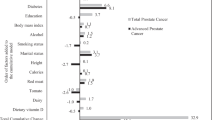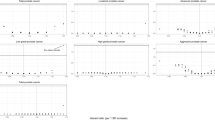Abstract
Purpose
Prostate cancer burden is disproportionate by race. Black men have the highest incidence and mortality rates. Rates for Hispanic men are significantly lower than for non-Hispanic Whites. Whether differences in prevalences of modifiable risk and protective factors for prostate cancer may explain these racial/ethnic differences remains unclear.
Methods
We used data from the National Health and Nutrition Examination Surveys (NHANES), which are cross-sectional and nationally representative. We selected factors known or suspected to be associated with prostate cancer and calculated risk scores combining key factors. Age-adjusted means and proportions were calculated for each factor and risk score by race/ethnicity. We estimated odds ratios (OR) using polytomous logistic regression.
Results
Prevalences of most factors are statistically significantly differed by race/ethnicity. In NHANES III, the prevalence of high risk score (i.e., > 25th percentile for all participants) was lower for all groups (non-Hispanic Black = 59.4%, non-US-born Mexican American = 51.4%, US-born Mexican American = 61.4%) vs. non-Hispanic White men (76.4%). Similar findings were observed for the fatal weighted risk score and for continuous NHANES.
Conclusions
Our findings from this nationally representative study suggest that a combination of multiple risk and protective factors may help to explain the lower rates of prostate cancer in Mexican Americans. However, variation in these factors did not explain the higher risk of prostate cancer in non-Hispanic Black men. No one lifestyle change can reduce prostate cancer equally across all racial/ethnic groups, and modifiable factors may not explain the increased risk in black men at all. Secondary prevention strategies may provide the most benefit for black men.
Similar content being viewed by others
References
Siegel RL, Miller KD, Jemal A (2019) Cancer statistics, 2019. CA Cancer J Clin 69(1):7–34
DeSantis CE et al (2019) Cancer statistics for African Americans, 2019. CA Cancer J Clin 69(3):211–233
Miller KD et al (2018) Cancer statistics for hispanics/latinos, 2018. CA Cancer J Clin 68(6):425–445
Singh GK, Jemal A (2017) Socioeconomic and racial/ethnic disparities in cancer mortality, incidence, and survival in the United States, 1950–2014: over six decades of changing patterns and widening inequalities. J Environ Public Health 2017:2819372
Perhar CH, Ebot EM, Wilson KM, Mucci LA (2018) The epidemiology of prostate cancer. Cold Spring Harb Perspect Med 8(12):a030361
Ballon-Landa E, Parsons JK (2018) Nutrition, physical activity, and lifestyle factors in prostate cancer prevention. Curr Opin Urol 28(1):55–61
Giovannucci E et al (2007) Risk factors for prostate cancer incidence and progression in the health professionals follow-up study. Int J Cancer 121(7):1571–1578
Caini S et al (2014) Sexually transmitted infections and prostate cancer risk: a systematic review and meta-analysis. Cancer Epidemiol 38(4):329–338
Sutcliffe S (2010) Sexually transmitted infections and risk of prostate cancer: review of historical and emerging hypotheses. Future Oncol 6(8):1289–1311
Islami F et al (2014) A systematic review and meta-analysis of tobacco use and prostate cancer mortality and incidence in prospective cohort studies. Eur Urol 66(6):1054–1064
Platz EA et al (2015) Asthma and risk of lethal prostate cancer in the health professionals follow-up study. Int J Cancer 137(4):949–958
Dickerman BA et al (2018) Midlife metabolic factors and prostate cancer risk in later life. Int J Cancer 142(6):1166–1173
Joshu CE et al (2012) Glycated hemoglobin and cancer incidence and mortality in the atherosclerosis in communities (ARIC) Study, 1990–2006. Int J Cancer 131(7):1667–1677
Kasper JS, Liu Y, Giovannucci E (2009) Diabetes mellitus and risk of prostate cancer in the health professionals follow-up study. Int J Cancer 124(6):1398–1403
Khankari NK et al (2016) Association between adult height and risk of colorectal, lung, and prostate cancer: results from meta-analyses of prospective studies and mendelian randomization analyses. PLoS Med 13(9):e1002118
MacInnis RJ, English DR (2006) Body size and composition and prostate cancer risk: systematic review and meta-regression analysis. Cancer Causes Control 17(8):989–1003
Esposito K et al (2013) Effect of metabolic syndrome and its components on prostate cancer risk: meta-analysis. J Endocrinol Invest 36(2):132–139
Zhao J et al (2016) Is alcohol consumption a risk factor for prostate cancer? A systematic review and meta-analysis. BMC Cancer 16(1):845
Aune D et al (2015) Dairy products, calcium, and prostate cancer risk: a systematic review and meta-analysis of cohort studies. Am J Clin Nutr 101(1):87–117
Bylsma LC, Alexander DD (2015) A review and meta-analysis of prospective studies of red and processed meat, meat cooking methods, heme iron, heterocyclic amines and prostate cancer. Nutr J 14:125
Stark JR et al (2009) Circulating prediagnostic interleukin-6 and C-reactive protein and prostate cancer incidence and mortality. Int J Cancer 124(11):2683–2689
YuPeng L et al (2015) Cholesterol levels in blood and the risk of prostate cancer: a meta-analysis of 14 prospective studies. Cancer Epidemiol Biomarkers Prev 24(7):1086–1093
Alshaker H et al (2015) Leptin signalling, obesity and prostate cancer: molecular and clinical perspective on the old dilemma. Oncotarget 6(34):35556–35563
Hu MB et al (2016) Genetic polymorphisms in leptin, adiponectin and their receptors affect risk and aggressiveness of prostate cancer: evidence from a meta-analysis and pooled-review. Oncotarget 7(49):81049–81061
Renehan AG et al (2004) Insulin-like growth factor (IGF)-I, IGF binding protein-3, and cancer risk: systematic review and meta-regression analysis. Lancet 363(9418):1346–1353
Liu Y et al (2011) Does physical activity reduce the risk of prostate cancer? A systematic review and meta-analysis. Eur Urol 60(5):1029–1044
Bansal D et al (2013) Type 2 diabetes and risk of prostate cancer: a meta-analysis of observational studies. Prostate Cancer Prostatic Dis, 16(2): 151–8, S1.
Rodriguez C et al (2005) Diabetes and risk of prostate cancer in a prospective cohort of US men. Am J Epidemiol 161(2):147–152
Liang Z et al (2016) Hypertension and risk of prostate cancer: a systematic review and meta-analysis. Sci Rep 6:31358
Farhat GN et al (2009) The association of bone mineral density with prostate cancer risk in the osteoporotic fractures in men (MrOS) study. Cancer Epidemiol Biomarkers Prev 18(1):148–154
Lin PH, Aronson W, Freedland SJ (2015) Nutrition, dietary interventions and prostate cancer: the latest evidence. BMC Med 13:3
Chen J, Song Y, Zhang L (2013) Lycopene/tomato consumption and the risk of prostate cancer: a systematic review and meta-analysis of prospective studies. J Nutr Sci Vitaminol (Tokyo) 59(3):213–223
Xu X et al (2016) Tomato consumption and prostate cancer risk: a systematic review and meta-analysis. Sci Rep 6:37091
Carleton AJ, Sievenpiper JL, de Souza R, McKeown-Eyssen G, Jenkins DJA (2013) Case-control and prospective studies of dietary α-linolenic acid intake andprostate cancer risk: a meta-analysis. BMJ Open 3(5):e002280
Liu Y et al (2014) Effect of aspirin and other non-steroidal anti-inflammatory drugs on prostate cancer incidence and mortality: a systematic review and meta-analysis. BMC Med 12:55
Kotani K et al (2013) High-density lipoprotein and prostate cancer: an overview. J Epidemiol 23(5):313–319
Lund Nilsen TI, Johnsen R, Vatten LJ (2000) Socio-economic and lifestyle factors associated with the risk of prostate cancer. Br J Cancer 82(7):1358–1363
Leavy J, Ambrosini G, Fritschi L (2006) Vietnam military service history and prostate cancer. BMC Public Health 6:75
Silventoinen K (2003) Determinants of variation in adult body height. J Biosoc Sci 35(2):263–285
Services, U.S.D.o.H.a.H., The health consequences of smoking: 50 years of progress. a report of the surgeon general. 2014, Atlanta, GA: U.S. Department of Health and Human Services, Centers for Disease Control and Prevention, National Center for Chronic Disease and prevention and Health Promotion, Office on Smoking and Health.
Alfaqih MA et al (2017) The current evidence on statin use and prostate cancer prevention: are we there yet? Nat Rev Urol 14(2):107–119
Mondul AM et al (2018) Longer-term lipid-lowering drug use and risk of incident and fatal prostate cancer in black and white men in the ARIC study. Cancer Prev Res (Phila) 11(12):779–788
Fowler SP et al (2013) Genetic epidemiology of cardiometabolic risk factors and their clustering patterns in Mexican American children and adolescents: the SAFARI Study. Hum Genet 132(9):1059–1071
Stern MC et al (2016) Variability in cancer risk and outcomes within US Latinos by national origin and genetic ancestry. Curr Epidemiol Rep 3:181–190
Eeles R et al (2014) The genetic epidemiology of prostate cancer and its clinical implications. Nat Rev Urol 11(1):18–31
Chu KC, Miller BA, Springfield SA (2007) Measures of racial/ethnic health disparities in cancer mortality rates and the influence of socioeconomic status. J Natl Med Assoc, 99(10): 1092–100, 1102–4
Kish JK et al (2014) Racial and ethnic disparities in cancer survival by neighborhood socioeconomic status in Surveillance, Epidemiology, and End Results (SEER) Registries. J Natl Cancer Inst Monogr 2014(49):236–243
Ward E et al (2004) Cancer disparities by race/ethnicity and socioeconomic status. CA Cancer J Clin 54(2):78–93
Rebbeck TR (2017) Prostate cancer genetics: variation by race, ethnicity, and geography. Semin Radiat Oncol 27(1):3–10
Funding
Elizabeth Platz is funded, in part, by Grant # P30 CA006973.
Author information
Authors and Affiliations
Corresponding author
Ethics declarations
Conflict of interest
The authors have no conflicts to disclose.
Additional information
Publisher's Note
Springer Nature remains neutral with regard to jurisdictional claims in published maps and institutional affiliations.
Electronic supplementary material
Below is the link to the electronic supplementary material.
Rights and permissions
About this article
Cite this article
Defever, K., Platz, E.A., Lopez, D.S. et al. Differences in the prevalence of modifiable risk and protective factors for prostate cancer by race and ethnicity in the National Health and Nutrition Examination Survey. Cancer Causes Control 31, 851–860 (2020). https://doi.org/10.1007/s10552-020-01326-9
Received:
Accepted:
Published:
Issue Date:
DOI: https://doi.org/10.1007/s10552-020-01326-9




